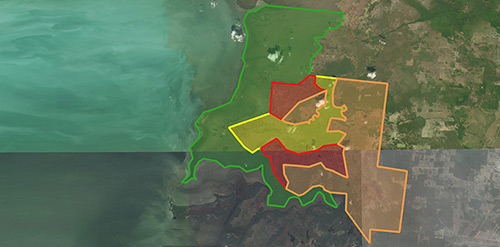LPAN Project Overview
The Mamantel/Panlao mangrove conservation and restoration project consists of 14,883 hectares of which 3,000 hectares are in need of restoration and reforestation. The project is located on the shores of Laguna Panlao and Laguna de Términos in the state of Campeche, Mexico. Mangrove species within the project include Rhizophora mangle, Avicennia germinans, Laguncularia racemosa and Conocarpus erectus. Mangroves in Mexico have accounted for approximately 24 Tg CO₂e emissions over the last 20 years. Due to the desire to create pasture land and as of late palm oil, there is a high threat level to slash and burn the mangroves. The government of Campeche decreed that there should be 100,000 hectares of palm oil in the state and thus far they have planted 30,000. Palm oil plantations have sprung up next to the project area and offers have been given to the landowners to sell the land for palm oil development.
The project’s conservation and restoration activities will be conducted by local community members and will be trained by an experienced local cooperative managed by women. The project leadership will include local members as well as financial benefit streams will flow directly to local families. Carbon finance from avoided emissions and the local community participation in the restoration and reforestation activities will provide incentive for the locals to preserve and protect the mangroves. In addition to the direct employment, the environmental services that will be provided by the ecosystem once recovered will include quality of habitat for fish and birds, improved water quality, as well as carbon sequestration of more than 6.035 million tCO2e over the life of the project and another 3.150 million tCO2e from avoided emissions.
Relevant ecosystem services provided beyond carbon include ecotourism, scientific tourism, adventure tourism that includes sports fishing and bird watching. In addition, local fishing for food, sustainable commercial fishing, and production of honey will be further benefits to the local community. The area is biologically rich, where 15 vegetative associations, with a total of 374 species are found. Threatened floral species found the area includes the Bletia purpurea, Bravaisia integerrima, B. tublifora. Endangered flora species found include the orchid Habenaria bractescens. Fauna estimates suggest that there are at least 1,468 species, both terrestrial and aquatic. Among the aquatic mammals, in the reserve one can find bottlenose dolphins (Tursiops truncatus) and manatees (Trichechus manatus). Endangered species include jaguar (Panthera onca), black-handed spider monkey (Ateles geoffroyi), American crocodile (Cocodrylus acutus) and Morelet’s crocodile (C. Moreletii). The hawksbill turtle (Eretmochelys imbricata), green turtle (Chelonia midas) and Kemp’s Ridley turtle (Lepidochelys kempi) are under special protection. Lastly, preserving urban wetlands in good condition, contribute to making cities and towns safer from the manifestations of climate change.
Project Area Highlights:
- 14,883 Ha Mangrove
- 11,883 Ha Conservation
- 3,000 Ha Restoration
- 2,150,000 tCO2 Avoided
- 6,035,000 tCO2 Sequestered

KML File available for download
[real3dflipbook id=’20’]
Project Supplemental Information
(Click to start the presentation)
Sustainable Development Goals (SDGs) and Impacts
For a full list and explanation of each SDG, click here
Project Impacts and Outcomes

Implementation Timeline
To Be Determined
Related Imagery and Resources
Ongoing Field Worklog Notes
B1-2019 Ground-truth and site visit
Lorem ipsum dolor sit amet lectus quisque taciti ultrices ornare nec mauris tellus nullam platea ante consectetur placerat nam malesuada erat iaculis sapien magna morbi tempus tortor volutpat fringilla pretium porta hac libero pulvinar eleifend ex feugiat pharetra laoreet eu tristique luctus maecenas fusce volutpat finibus vestibulum eros viverra amet
